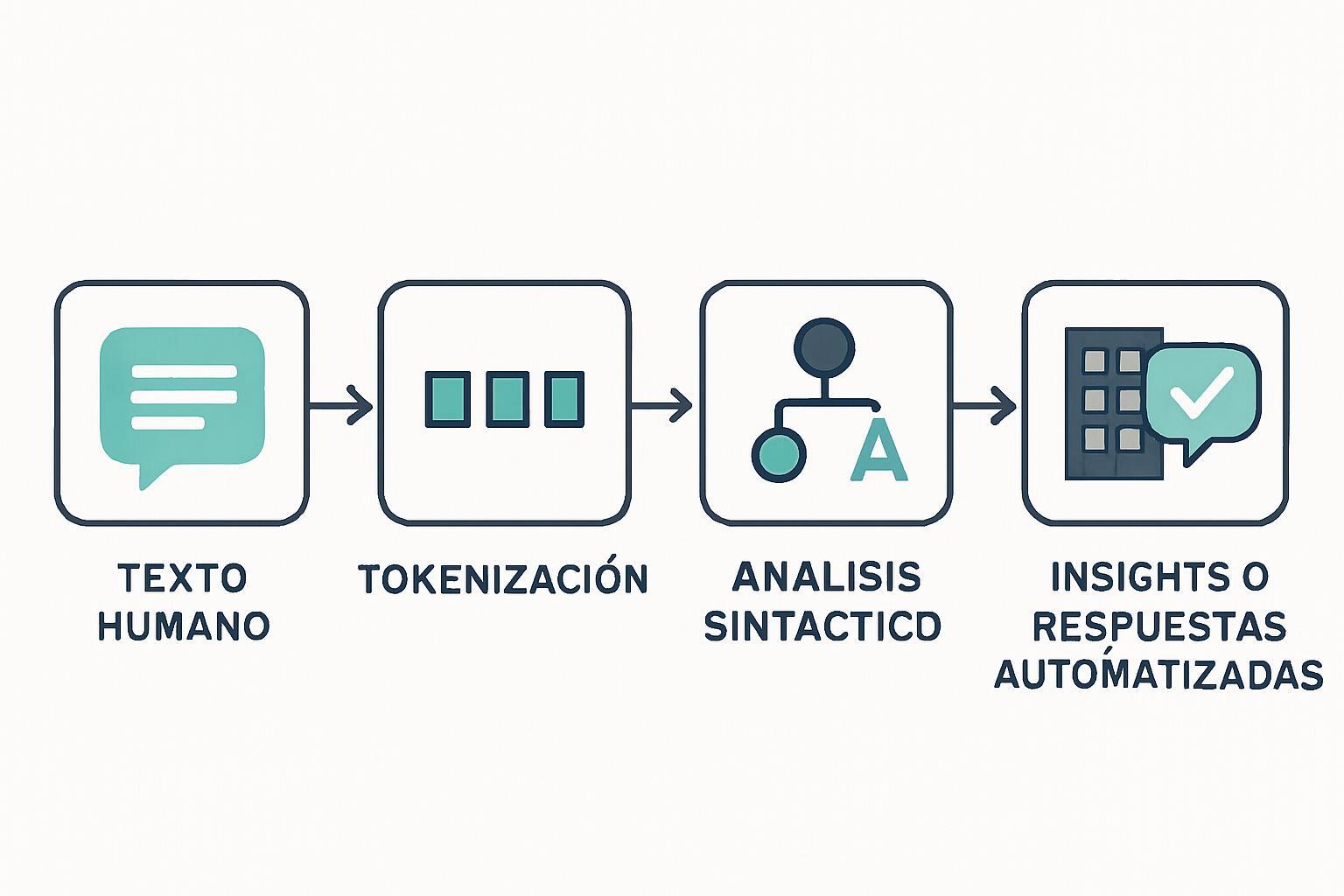In an increasingly digital business world, Natural Language Processing (NLP) has evolved from an emerging technology to a strategic component for organizations seeking to optimize processes and enhance customer experience. This branch of artificial intelligence is revolutionizing how companies manage information and communicate with their users.
What is NLP? Fundamentals of Natural Language Processing
Natural Language Processing (NLP) is a discipline that combines artificial intelligence, computational linguistics, and machine learning to enable machines to understand, interpret, and generate human language meaningfully. Unlike traditional programming based on strict rules, NLP uses advanced algorithms that can capture the nuances of natural language.
The importance of natural language processing lies in its ability to bridge the gap between human communication (inherently unstructured) and machine language (structured and rule-based). This technology allows computers to process text and voice, understand their meaning, and respond naturally and contextually.

Essential Components of NLP
Natural language processing operates through several interconnected technical layers that enable its effective functioning:
- Tokenization: Divides text into smaller units (words, phrases, or symbols) for processing.
- Syntactic analysis: Examines the grammatical structure of sentences to determine relationships between words.
- Lemmatization: Reduces words to their base or root form to facilitate analysis.
- Entity recognition: Identifies and classifies key elements such as names, organizations, or locations within the text.
- Sentiment analysis: Determines the attitude, opinions, and emotions expressed in a text.
These components work together to allow NLP systems to understand both the explicit content and the implicit meaning of human language, creating the foundation for practical and effective business applications.
Transformative Business Applications of NLP
Natural language processing is revolutionizing various business sectors with practical applications that optimize daily operations:
Automated Customer Service
Chatbots and virtual assistants powered by NLP offer 24/7 customer support, answering frequently asked questions and escalating complex issues to human agents when necessary. This implementation can reduce operating costs by up to 40% while significantly improving the user experience.
Sentiment Analysis
Companies use NLP to monitor the perception of their brand on social networks, reviews, and surveys. This capability allows for detecting emerging problems, measuring the impact of marketing campaigns, and adjusting strategies in real-time based on customer feedback.
Document Processing
In sectors such as banking, legal, and health, NLP automates the extraction of key information from contracts, medical reports, and legal documents. This application saves time, reduces human error, and allows professionals to focus on higher value-added tasks that require specialized judgment.
Sales Process Optimization
Natural language processing transforms business processes by analyzing sales calls, identifying cross-selling opportunities, and automating customer follow-up. Companies that implement this technology report increases of up to 25% in conversion rates.
Tangible Benefits of NLP for Businesses
The implementation of natural language processing offers significant competitive advantages:
- Operational efficiency: Automates repetitive tasks related to text and communication, reducing operating costs.
- Improved customer experience: Allows faster and more personalized responses, increasing satisfaction.
- Actionable insights: Extracts valuable information from large volumes of unstructured data that were previously difficult to analyze.
- Scalability: Manages growing volumes of interactions without the need to proportionally increase staff.
- Consistency: Guarantees uniform responses and compliance with protocols in all interactions.
According to recent studies, companies that implement NLP solutions experience an average 30% reduction in information processing time and a 35% increase in the accuracy of textual data analysis.
Popular NLP Tools and Platforms
The market offers various technological solutions for implementing natural language processing in business environments:
- Google Cloud Natural Language API: Offers sentiment analysis, entity extraction, and content classification with high accuracy.
- IBM Watson Natural Language Understanding: Provides advanced text analysis, emotion detection, and semantic relationship analysis.
- Microsoft Azure Text Analytics: Facilitates sentiment analysis, key phrase extraction, and entity recognition in multiple languages.
- Amazon Comprehend: Offers text analysis capabilities to extract insights from documents, identify languages, and detect sensitive information.
- SpaCy: Open-source NLP library with a focus on efficiency and ease of use, ideal for custom projects.
The choice of the right tool will depend on factors such as data volume, specific business requirements, available budget, and the organization's internal technical capabilities.
NLP in Spanish: Special Considerations
The implementation of NLP in Spanish presents specific challenges and opportunities for companies in Spanish-speaking markets:
Unlike English, Spanish has a richer and more complex morphology , with numerous verb conjugations (Spanish has 17 verb tenses compared to 5 in English) and agreement of gender and number. This requires models specifically trained to capture these linguistic nuances.
The dialectal variations between different Spanish-speaking countries (such as lexical differences between Iberian and Latin American Spanish) add complexity to processing. A model trained with Iberian Spanish may have up to a 15% error when processing Latin American regional expressions.
To effectively implement NLP in Spanish , companies should consider:
- Localized training datasets that reflect the linguistic variations of their target market.
- Specialized tools such as SpaCy-ES, Freeling, or multilingual BERT, optimized for the particularities of Spanish.
- Continuous evaluation of performance in different dialectal contexts if operating in multiple Spanish-speaking countries.
Challenges in Business NLP Implementation
Despite its benefits, natural language processing presents significant challenges:
- Linguistic ambiguity: Human language is inherently ambiguous, with words and phrases that can have multiple interpretations depending on the context.
- Data quality: NLP models require large amounts of clean and representative data for effective training.
- Algorithmic biases: Models can perpetuate biases present in the training data, requiring careful evaluation and adjustment.
- Integration with existing systems: Incorporating NLP solutions into legacy technological architectures can present technical challenges.
- Realistic expectations: Setting clear and measurable objectives helps manage expectations about the capabilities and limitations of the technology.
To overcome these challenges, it is advisable to start with well-defined pilot projects before large-scale implementations, allowing incremental adjustments based on results.
Future Trends in NLP
The field of natural language processing is evolving rapidly, with innovations that will expand its business impact:
- Multimodal models that integrate text, images, and audio for a more complete understanding of the communicative context.
- Improved conversational NLP that allows for more natural and contextual interactions with users.
- Domain-specific language processing optimized for particular industries such as health, finance, or legal.
- Ethical and transparent NLP with tools to identify and mitigate biases in linguistic models.
- Democratization of NLP through no-code platforms that make this technology accessible to companies without specialized technical expertise.
According to market projections, the global value of NLP will grow at an annual rate of 21.82%, reaching $43.290 billion in 2025, driven by increasing business adoption.
Business Success Stories with NLP
Numerous organizations have transformed their operations through the strategic implementation of natural language processing :
In the banking sector, Banco Santander implemented a chatbot system called Sandrine that resolves 78% of inquiries in Spanish, recognizing regional variants and reducing operating costs by 40%.
In the health sector, the hospital group Vithas uses advanced NLP models to review medical reports in Spanish, detecting inconsistencies with 92% accuracy and significantly improving the quality of clinical documentation.
In retail, a major Latin American chain analyzed 2.3 million comments on social networks using NLP, identifying regional patterns in customer language that allowed them to adapt their communication strategies, increasing customer satisfaction by 25%.
How to Get Started with NLP in Your Company
To effectively implement natural language processing in your organization:
- Identify specific problems that NLP can solve: automation of documentary processes, analysis of customer feedback, or improvement of service systems.
- Evaluate your available data and determine if you have enough textual information to train or implement NLP models.
- Select the appropriate technology based on your needs, budget, and internal technical capabilities.
- Start with pilot projects in limited areas to demonstrate value before wider implementations.
- Measure results with clear KPIs such as time savings, improved customer satisfaction, or accuracy in data analysis.
The key to success lies in a gradual approach, defining clear objectives and continuously evaluating results to refine the implementation.
Conclusion: The Business Future Lies in NLP
Natural language processing is no longer a futuristic technology, but a business reality with practical applications and tangible benefits. Organizations that incorporate NLP into their digital strategies will be better positioned to optimize processes, improve customer experiences, and extract value from their unstructured data.
For Spanish-speaking companies, NLP in Spanish offers particular opportunities to connect with their markets more effectively, although it requires special considerations regarding linguistic diversity and regional adaptation. With a constantly growing market and increasingly accessible technologies, the time to explore and implement natural language processing solutions is now.
The continuous evolution of this technology promises to further expand its capabilities and applications, fundamentally transforming how companies manage information, make decisions, and communicate with their customers in the digital age.



